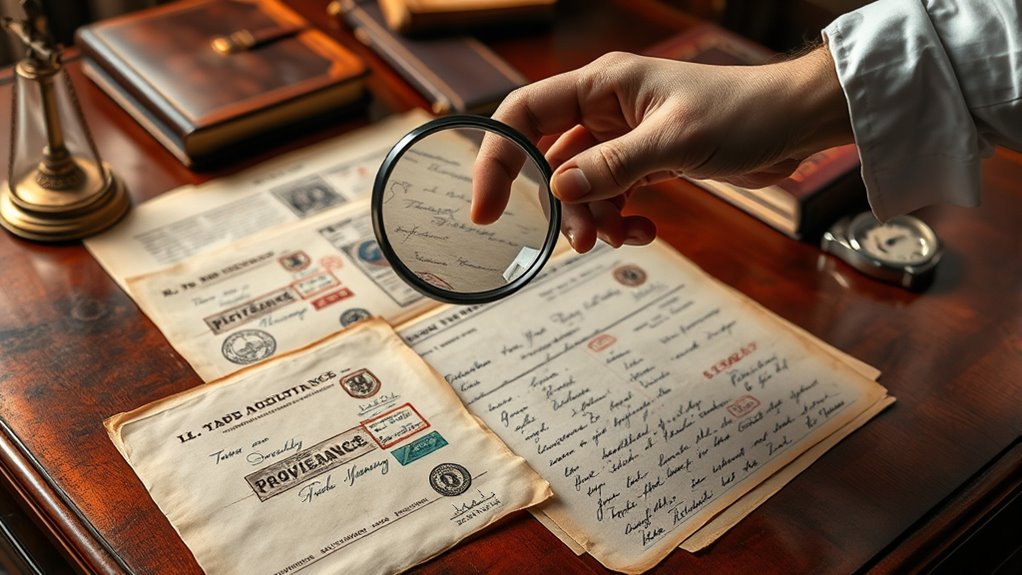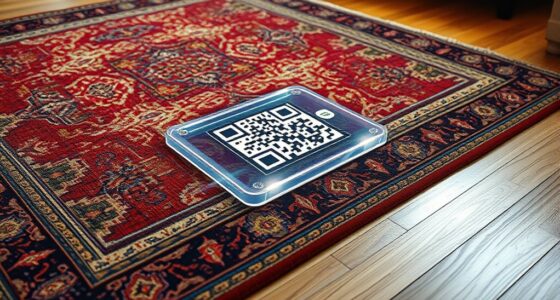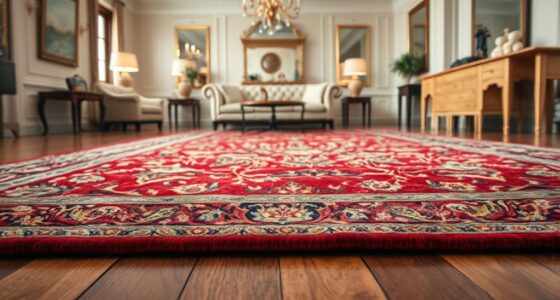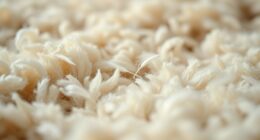To master rug provenance papers for resale, you’ll want to verify key details like signatures, seals, and regional motifs to confirm authenticity. Check for inconsistencies or signs of tampering, and understand the cultural and historical context to deepen your knowledge. Properly documenting and securely storing records boosts buyer confidence and resale value. If you want to guarantee your provenance enhances your dish, understanding these elements can guide you to a more successful sale.
Key Takeaways
- Verify and document provenance thoroughly to ensure rug authenticity, value, and legal security for resale.
- Check for authentic markers such as signatures, seals, cultural symbols, and consistent details in provenance papers.
- Understand regional motifs, weaving techniques, and artistic styles to authenticate cultural and historical origins.
- Maintain organized, secure storage of physical and digital provenance records, updating regularly for accuracy.
- Consult qualified appraisers and legal experts to confirm provenance authenticity and resolve potential disputes.
Key Elements to Identify in Provenance Documents
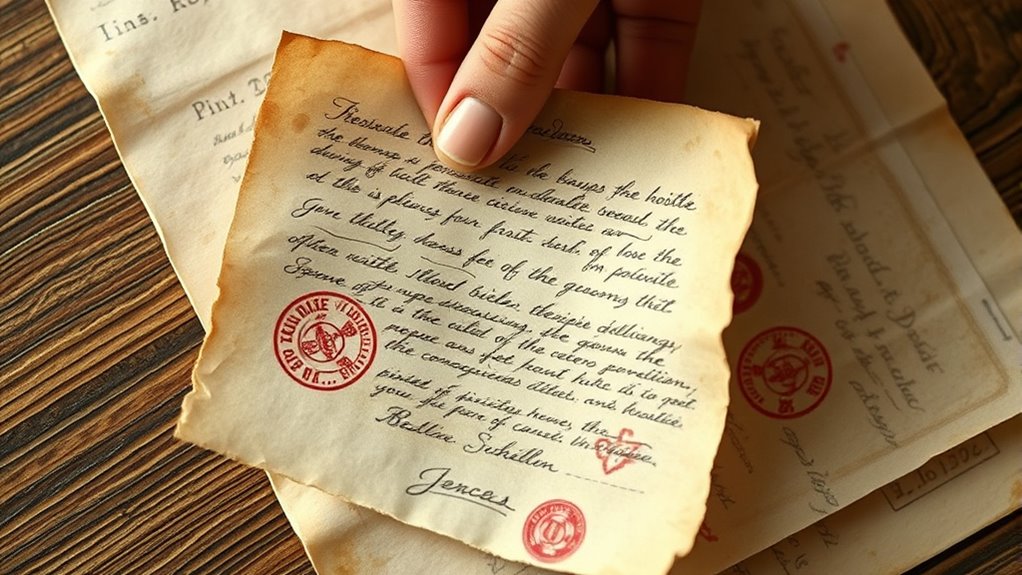
When examining provenance documents for rugs, it’s essential to focus on specific key elements that verify authenticity and history. Look for authenticity markers such as signatures, stamps, or detailed descriptions that confirm the rug’s origin. Cultural annotations are equally important; these often include references to the geographic region, tribe, or weaving tradition, providing context that supports the rug’s provenance. Pay attention to date stamps or historical notes, which can establish a timeline for the piece. Clear, consistent language and legible handwriting also boost credibility. By carefully analyzing these key elements, you can better gauge the rug’s authenticity and cultural significance, ensuring you’re making an informed decision when evaluating provenance documents for resale. Additionally, understanding the importance of transparency in affiliate relationships can help you verify the credibility of sources providing provenance information. Recognizing AI-driven verification methods can further enhance the accuracy of provenance assessments, especially as technology becomes more integrated into authentication processes. Incorporating digital authentication tools can streamline this process and provide additional assurance of provenance accuracy. Paying attention to material details can reveal clues about the rug’s origin and authenticity, supporting your evaluation efforts. Furthermore, being aware of certification standards can help differentiate genuine provenance documentation from potential forgeries.
Authenticity Checks and Common Red Flags
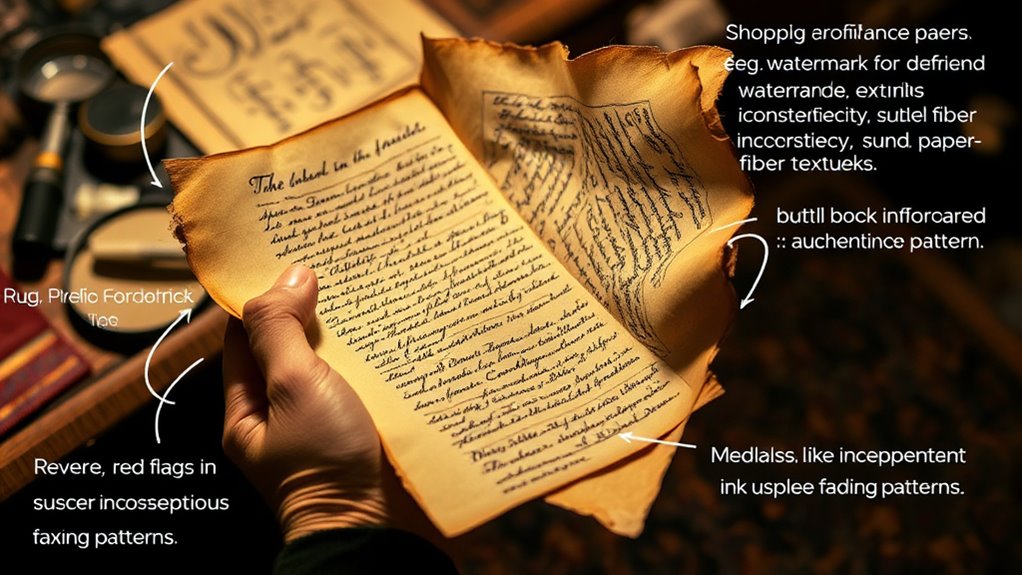
Authenticity checks are essential in verifying the legitimacy of rug provenance documents, as counterfeit or misleading evidence can easily deceive even seasoned collectors. To spot forgery detection issues, examine the paper quality, ink consistency, and seals or signatures for signs of tampering. Look for inconsistencies in fonts, spelling errors, or irregularities that suggest the document isn’t genuine. Pay close attention to the provenance details—discrepancies in ownership history or dates often raise red flags. Authentic documentation should have a clear, logical trail and verifiable sources. Remember, counterfeiters often replicate basic features, but subtle signs like uneven printing or inconsistent formatting reveal false documentation authenticity. Developing a keen eye for these red flags helps ensure you don’t fall for forged provenance papers. Additionally, understanding the importance of document authenticity can significantly improve your ability to differentiate genuine provenance from fakes. Recognizing authenticity markers such as consistent branding and official seals further enhances your detection skills. Being aware of home improvement principles, such as proper organization and attention to detail, can also aid in thorough document examination. Moreover, familiarity with vetted sources of provenance information can help establish more reliable verification processes.
Interpreting the Historical and Cultural Context
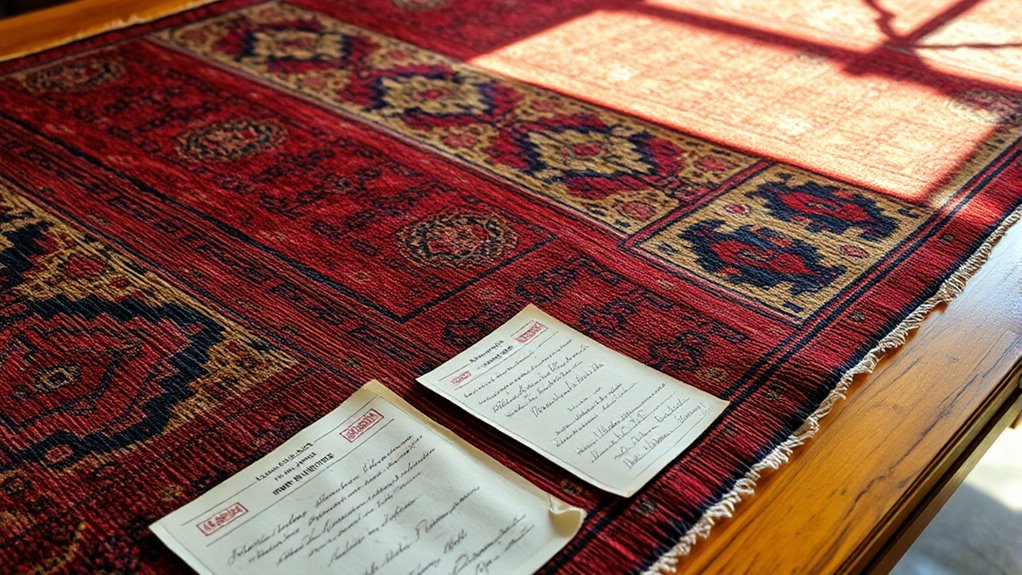
Understanding the historical and cultural context of a rug provides essential insights into its origin and significance. By analyzing symbols, motifs, and weaving techniques, you can uncover the cultural symbolism embedded within the piece. Recognizing patterns linked to specific regions or tribes reveals its historical significance and helps authenticate its provenance. This context enriches your understanding of the rug’s story and value. Key aspects to consider include:
Understanding a rug’s origin and significance enhances its story and value.
- Regional motifs and their meanings
- Traditional dyeing and weaving methods
- Influences from neighboring cultures
- Symbolic patterns representing beliefs or customs
Regional motifs and their meanings are often indicative of specific cultural identities and stories woven into the design. Familiarity with these elements allows you to interpret a rug’s deeper cultural message, helping you determine its authenticity and historical importance for resale. Additionally, understanding traditional techniques used in the creation process can further validate the piece’s origin and craftsmanship. Recognizing weaving patterns can also provide clues about the age of the rug and the specific community that produced it. Knowing the artistic styles associated with different regions can further enhance your ability to date and authenticate the piece. Exploring techniques of dyeing can offer additional insights into the craftsmanship and historical period of the rug.
Leveraging Provenance to Enhance Resale Value
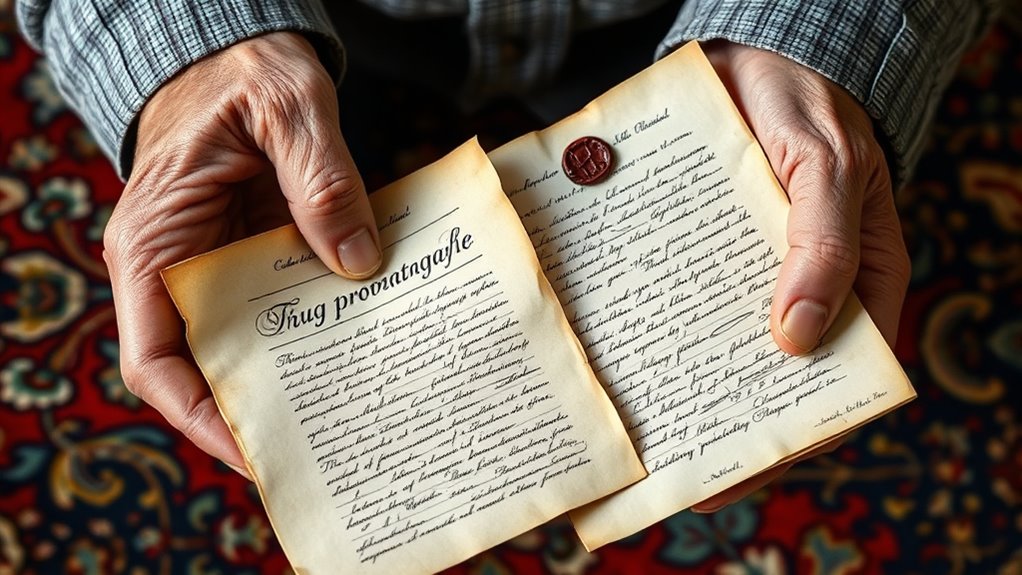
Leveraging provenance is a powerful strategy to boost a rug’s resale value, as it directly influences buyers’ confidence and perceived worth. You can do this by highlighting detailed provenance papers that include appraisal techniques used to assess the rug’s authenticity and condition. These documents demonstrate transparency, reassuring buyers about the rug’s genuine origin and quality. Additionally, maintaining accurate restoration records adds value, showing that any repairs or cleaning were professionally handled, preserving the rug’s integrity. When you present a clear, well-documented provenance, you create a compelling story that justifies a higher price. Buyers are more willing to invest when they trust the provenance and see documented evidence of careful preservation and appraisal, making your rug stand out in a competitive resale market. Incorporating AI-driven security systems can also ensure the authenticity of provenance documentation, further increasing buyer trust. Emphasizing documentation accuracy enhances credibility and helps prevent potential disputes over the rug’s history. Familiarity with privacy policies can also help you understand how to protect sensitive provenance information while sharing it with potential buyers. Cultivating an understanding of creative practice can also inspire innovative ways to present and verify provenance, making the process more engaging and trustworthy.
Practical Tips for Verifying and Preserving Rug Provenance Papers
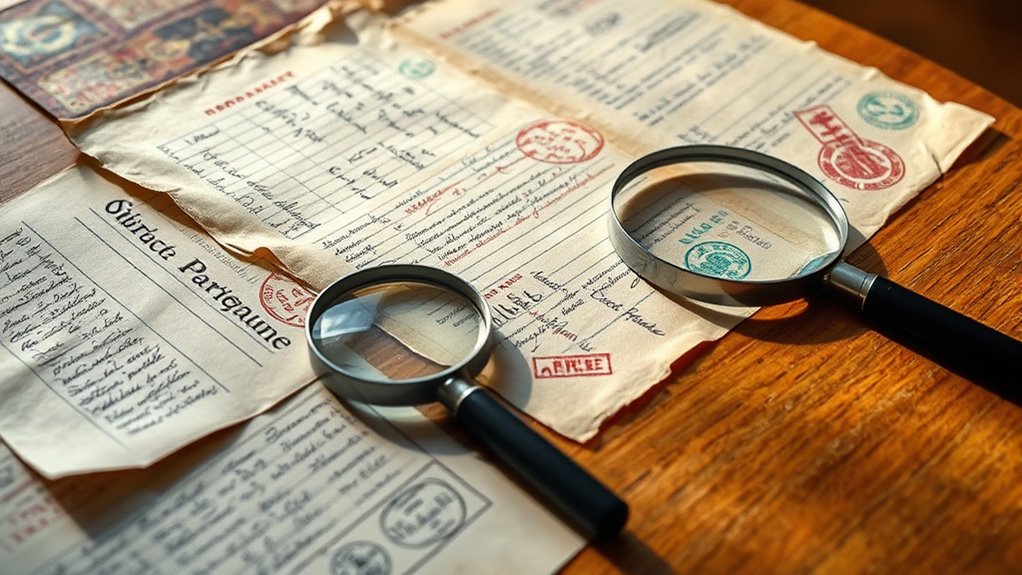
Secure and accurate provenance papers are key to maintaining a rug’s value, so verifying and preserving these documents should be a top priority. To do this effectively, always examine the authenticity of the papers, checking for signs of tampering or forgery. Keep digital and physical copies in safe, organized locations. Be aware of restoration challenges that might alter documentation or mask authenticity. Understand legal considerations, such as provenance disputes or theft claims, to avoid future issues. When in doubt, consult experts or appraisers to verify provenance and ensure proper preservation.
Verifying and preserving provenance papers safeguards your rug’s value and authenticity.
- Cross-reference with reputable sources
- Store documents in acid-free, protected environments
- Regularly update records after restoration or appraisal
- Consult legal professionals for provenance disputes
Frequently Asked Questions
How Can I Determine the True Age of a Rug From Provenance Papers?
To determine a rug’s true age from provenance papers, focus on age verification details like the dates of origin, ownership records, and any documented repairs or restorations. Check for provenance authenticity by examining the paper’s stamps, signatures, and consistency with known historical data. Cross-reference these details with expert sources or appraisers. Accurate provenance papers help confirm the rug’s age, ensuring you understand its true history and value confidently.
What Are the Legal Implications of Selling a Rug With Questionable Provenance?
Did you know that nearly 25% of rug sales face legal risks due to questionable provenance? Selling a rug with doubtful provenance can lead to fraud detection issues, legal liability, and potential lawsuits. You must guarantee transparency and authenticity to avoid these risks. Failing to do so might result in fines or even criminal charges. Always verify provenance thoroughly before resale to protect yourself legally and maintain buyer trust.
How Do Provenance Papers Impact Insurance Valuation for High-End Rugs?
Provenance documentation substantially impacts insurance valuation for high-end rugs because it verifies authenticity and origin. When you have clear provenance papers, insurers view the rug as more valuable and authentic, often leading to higher coverage and better reimbursement in case of damage or loss. Without proper documentation, your insurance claim could be reduced or denied, making it essential to keep detailed provenance records to guarantee accurate insurance valuation.
Can Provenance Documents Be Forged or Tampered With Easily?
Forgery risks exist with provenance documents, so you should be cautious. Skilled forgers can sometimes create convincing fakes, but tampering is not easy if you perform proper document verification. Always check for authenticity through trusted sources or experts. By verifying provenance papers thoroughly, you reduce the chance of purchasing or selling a rug based on forged or tampered documents, ensuring your transaction remains secure and legitimate.
What Are the Best Sources to Verify the Authenticity of Provenance Papers?
You’re on the right track by asking how to verify provenance papers. To avoid getting caught in a web of lies, rely on expert appraisers and reputable auction house records. These sources have the experience and resources to authenticate documents thoroughly. Don’t forget, a little due diligence goes a long way—trustworthy verification helps guarantee your rug’s provenance is legit and protects your investment.
Conclusion
Mastering rug provenance papers is your key to revealing their true value, like a treasure map guiding you through hidden riches. By knowing what to look for, spotting red flags, and understanding their story, you turn a simple rug into a prized heirloom. With careful verification and preservation, you guarantee its legacy endures. Think of provenance papers as the threads weaving your rug’s story—keep them intact, and watch your investment flourish like a well-tended garden.
